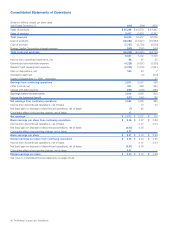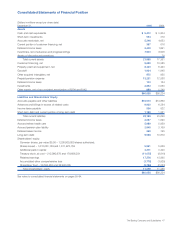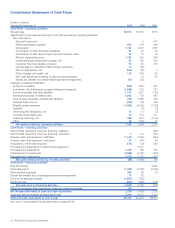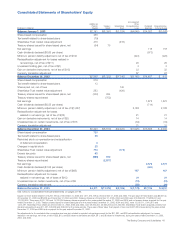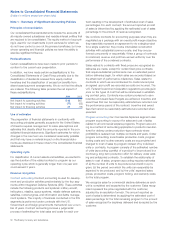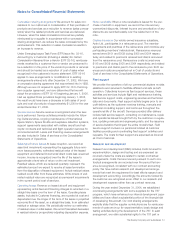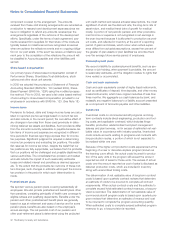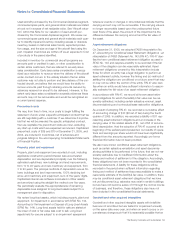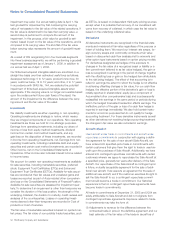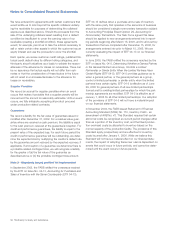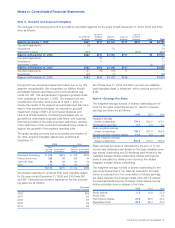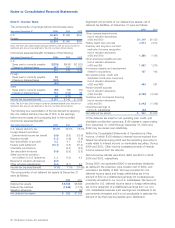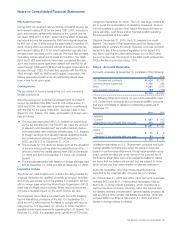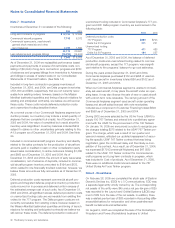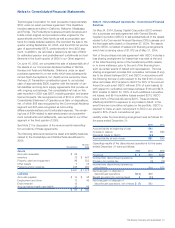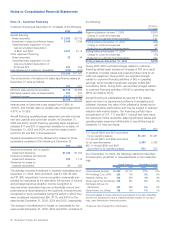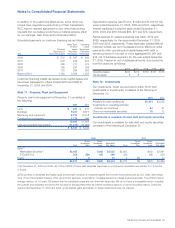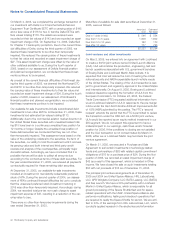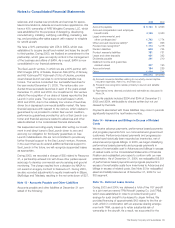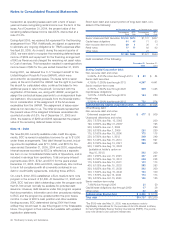Boeing 2005 Annual Report Download - page 58
Download and view the complete annual report
Please find page 58 of the 2005 Boeing annual report below. You can navigate through the pages in the report by either clicking on the pages listed below, or by using the keyword search tool below to find specific information within the annual report.Notes to Consolidated Financial Statements
We have entered into agreements with certain customers that
would entitle us to look beyond the specific collateral underly-
ing the receivable for purposes of determining the collateral
exposure as described above. Should the proceeds from the
sale of the underlying collateral asset resulting from a default
condition be insufficient to cover the carrying value of our
receivable (creating a shortfall condition), these agreements
would, for example, permit us to take the actions necessary to
sell or retain certain other assets in which the customer has an
equity interest and use the proceeds to cover the shortfall.
Each quarter, we review customer credit ratings, published his-
torical credit default rates for different rating categories, and
third-party aircraft valuations as a basis to validate the reason-
ableness of the allowance for losses on receivables. There can
be no assurance that actual results will not differ from esti-
mates or that the consideration of these factors in the future
will not result in an increase/decrease to the allowance for
losses on receivables.
Supplier Penalties
We record an accrual for supplier penalties when an event
occurs that makes it probable that a supplier penalty will be
incurred and the amount is reasonably estimable. Until an event
occurs, we fully anticipate accepting all product procured
under production related contracts.
Guarantees
We record a liability for the fair value of guarantees issued or
modified after December 31, 2002. For a residual value guar-
antee where we received a cash premium, the liability is equal
to the cash premium received at the guarantee’s inception. For
credit and performance guarantees, the liability is equal to the
present value of the expected loss. For each future period the
credit or performance guarantee will be outstanding, we deter-
mine the expected loss by multiplying the creditor’s default rate
by the guarantee amount reduced by the expected recovery, if
applicable. If at inception of a guarantee we determine there is
a probable related contingent loss, we will recognize a liability
for the greater of (a) the fair value of the guarantee as
described above or (b) the probable contingent loss amount.
Note 2 - Standards Issued and Not Yet Implemented
In September 2005, the FASB ratified the consensus reached
by the EITF on Issue No. 04-13, Accounting for Purchases and
Sales of Inventory with the Same Counterparty (EITF 04-13).
EITF 04-13 defines when a purchase and a sale of inventory
with the same party that operates in the same line of business
should be considered a single nonmonetary transaction subject
to Accounting Principles Board Opinion 29, Accounting for
Nonmonetary Transactions. The Task Force agreed this Issue
should be applied to new arrangements entered into in report-
ing periods beginning after March 15, 2006, and to all inventory
transactions that are completed after December 15, 2006, for
arrangements entered into prior to March 15, 2006. We are
currently evaluating the impact of EITF 04-13 on our financial
statements.
In June 2005, the FASB ratified the consensus reached by the
EITF on Issue No. 04-5, Determining Whether a General Partner,
or the General Partners as a Group, Controls a Limited
Partnership or Similar Entity When the Limited Partners Have
Certain Rights (EITF 04-5). EITF 04-5 provides guidance as to
when a general partner, or the general partners as a group,
control a limited partnership or similar entity when the limited
partners have certain rights. EITF 04-5 is effective as of June
29, 2005 for general partners of all new limited partnerships
formed and for existing limited partnerships for which the part-
nership agreements are modified. EITF 04-5 is effective as of
January 1, 2006 for all other limited partnerships. Our adoption
of the provisions of EITF 04-5 will not have a material impact
on our financial statements.
In November 2004, the FASB issued Statement of Financial
Accounting Standard (SFAS) No. 151, Inventory Costs - an
amendment of ARB No. 43. This Standard requires that certain
abnormal costs be recognized as current period charges rather
than as a portion of the inventory cost, and that fixed produc-
tion overhead costs be allocated to inventory based on the
normal capacity of the production facility. The provisions of this
Standard apply prospectively and are effective for inventory
costs incurred after January 1, 2006. While we believe this
Standard will not have a material effect on our financial state-
ments, the impact of adopting these new rules is dependent on
events that could occur in future periods, and cannot be deter-
mined until the event occurs in future periods.
56 The Boeing Company and Subsidiaries


